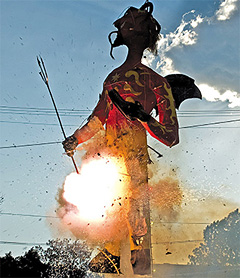
|  |  |  Editorials | Issues | April 2009 Editorials | Issues | April 2009  
In Mexico, Crisis is this Year's Big Judas Figure
 The News The News
go to original


| | A gigantic devil-like Judas figure filled with fireworks is set alight on Saturday in Mexico City's Iztapalapa borough as Holy Week traditions and festivities continued in the capital. (Cuartoscuro/Rodolfo Angulo) |  |
If you want to know who sits atop Mexico´s current villains list, just wait for Holy Saturday. That´s when the nation´s most unpopular politicians, crooks, business tycoons and even popular culture figures are burned in effigy as Judas figures.

But this year, one of the most popular papier maché figures to be filled with firecrackers and set alight may have been an economic crisis-causing Uncle Sam, according to local media reports.

Both El Universal and La Jornada visited the Merced market stall of the Miguel Linares family, perhaps the city´s most famous Judas figure-makers. écording to the family, patrons this year have most wanted to take out their frustrations on the economic crisis, which the Linares´ have chosen to represent with an Uncle Sam figure clutching a globe in one hand and a bag of money in the other.

"It´s our interpretation of the crisis, because the blame lies with the gringos, who dragged the rest of us into it," Elsa Linares told El Universal.

Another big seller has been a scarecrow-like figure representing global warming, the Linares´ said. Other figures reported on sale at the market included a petty thief, an abusive husband/boyfriend and the standard red devil-like doll representing Judas himself.

The tradition of burning Judas figures was brought to Mexico by the Spanish, who had burned the figures since the Inquisition as representations of religious fugitives.

But Mexicans quickly adapted the tradition as a form of political satire.

Former president Antonio López de Santa Anna was reportedly so upset by the practice that he decreed in 1853 that no dolls ridiculing a specific person or social class could be sold or burned. |

 |
|  |



